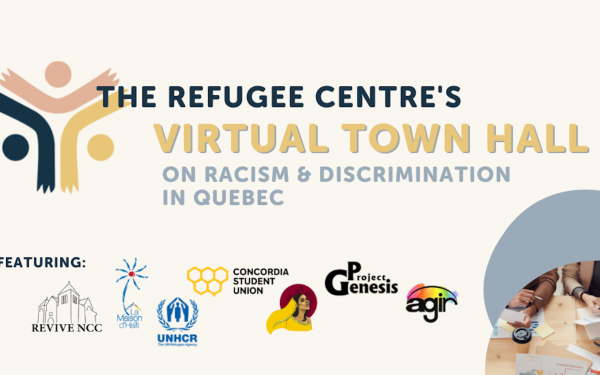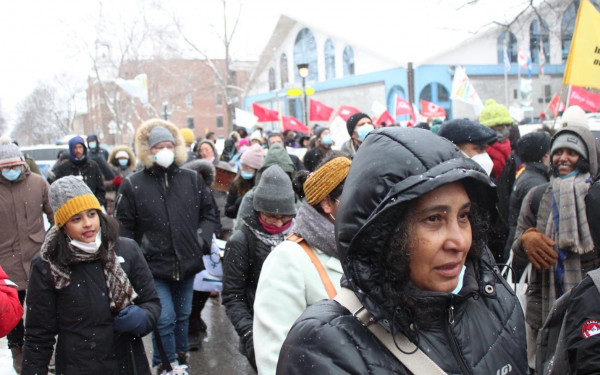Burnt-out healthcare staff are holding Park Extension’s overwhelmed system together
Park Extension is experiencing a crisis in healthcare as understaffed clinics and overworked employees are left scrambling to meet the needs of the borough’s population. Graphic Joey Bruce
With limited tools at their disposal, workers are being forced to take on a load much greater than in other boroughs
Dr. Jhanzaib Sherwani is a South Asian doctor who began his practice in Park Extension in 2021. He sees 50 patients daily at his clinic in Park Extension. Most clinic doctors in Montreal see 30 per day. “[It] is overwhelming at times. There’s a lot of pressure,” said Sherwani.
He feels pressured to spend extra time with those who need it, or book an appointment for them because they either don’t understand how to do so or don’t have internet access at home. Because a lot of his clients don’t speak French or English, Sherwani feels pressured to explain where to get blood tests, electrocardiograms, and chest X-rays in a language they understand, since the staff who will be doing those tests only speak French or English. If nothing changes in the foreseeable future, Sherwani’s only choice is to continue to work to the point of exhaustion.
There are three clinics in Park Extension to serve its dense population. Clinique Parc-X has two full-time family doctors. The Centre locaux de services communautaires de Parc-Extension has at least 14, but most of them work one day or half-days. One is a confirmed full time doctor. Additionally, language barriers and internet shortages prevent most of the residents from applying for a family doctor online.
The reality of the state of healthcare in Park Extension is far from sustainable, as doctors like Sherwani have to make up for the gap in staffing by taking on many more patients than they regularly would. Clinique Parc-X has seen 25,260 appointments over the last two years, and roughly 8,142 appointments were made in the last six months, according to Sherwani’s electronic medical records. “I’ve had to turn down many people because I can’t take them on. I’m booked months down,” said Sherwani.
“You can’t ask [all doctors] to do what I did. It’s not feasible.” — Dr. Jhanzaib Sherwani
At the heart of doctor understaffing are the limitations of the Plans régionaux d'effectifs médicaux, a permit that works on a regional basis, enabling doctors to practice within a given area. However, the process is lengthy and the permits are restrictive. When a doctor is given a permit to a region, they have to dedicate at least 55 per cent of their practice to that sector. Park Extension is grouped with the boroughs of Côte-des-Neiges and Métro, so a doctor with a PREM to Park Extension’s group would have to spend most of their time in those boroughs. Most importantly, Côte-des-Neiges has McGill University hospitals such as St. Mary’s Hospital. The Jewish General Hospital is also a popular workplace. Most doctors apply to work at the bigger institutions, and so the majority of the limited permits available go out to them. The competition between the small clinics of Park Extension and the massive health centres of Côte-des-Neiges leaves the former with little chance of seeing new doctors.
When Sherwani first applied to work in Park Extension in 2019, he could not get in. He had to apply to the region of Ahuntsic and Montreal-North instead to become eligible for the Mobilité inter-regionale status. That would allow him to re-apply for the Park Extension region with the experience for him to be higher priority. However, that required him to work 200 days and he ended up registering 500 patients in the borough of Ahuntsic. While taking on patients is not mandatory, the process to re-apply for a PREM takes a long time and remains competitive, even with the MIR. He was also interviewed alongside the other candidates.
“The borough is a desert for clinics. […] We need a system-wide change.” — Dr. Juan Carlos Luis Chirgwin
Once he got in, he was still left with those 500 patients that he had to take on, plus those that he sees now in his clinic in Park Extension. “It’s very complicated. New doctors who aren’t eligible for the MIR status don’t want to risk not getting a permit to Park Ex because of the competitiveness. […] You can’t ask them all to do what I did. It’s not feasible,” said Sherwani. The process of admission to the coveted sector, especially for newer applicants who don’t have the MIR, is lengthy and risky. The doctors who want to work in Park Extension may very likely never see their permits.
Park Extension is lacking more than just doctors. Nurses, technicians, and translators to name a few are vital to help patient management, but “they end up at their limit quickly because there are so many people. The borough is a desert for clinics. […] We need a system-wide change,” said Dr. Juan Carlos Luis Chirgwin, who works at the CLSC of the borough as a family doctor. Alongside his practice, he regularly involves himself in community work and seeks to understand the health predeterminants of the population.
In practice in Park Extension since 2001, Dr. Chirgwin also runs a screening clinic for asylum seekers on Thursdays to detect health problems in them before they become serious. However, he is aware that he cannot keep juggling so much forever. “It is overwhelming. I know it’s not a sustainable solution,” Chirgwin said. “Eventually, I will retire. I’m hoping I will inspire someone to take my place, but it’s going to be another lone doctor.”
He believes that representative data would help the province paint a better picture of the neighbourhood. “I try my best to renew their medications and to refer them to other services, but I can’t help them more. I can’t do more,” he said, shakily.
Chirgwin trusts that properly remediating a problem is to understand its needs. He shared that when it comes to Park Extension, it would practically require provincial representatives to see the situation for themselves. There is a need for data that points to the many asylum seekers who don’t have citizenship, to those with chronic illnesses, to the young and big families that don’t have a pediatric clinic for their children.
“It’s really hard to have asylum seekers ask me where they can get a doctor. Getting yourself a family doctor in Quebec, today, is a nearly impossible task,” said Chirgwin.
Chirgwin said one of the ways to go about helping the issue is to work with community organizations and the patients he sees at the CLSC to educate them on all the services and programs it has. In this way, the doctor’s load is distributed a bit more and those who need pregnancy follow-ups or psychological help won’t wait in the same line as someone with pain that needs to be investigated.
“[We] receive lower funding because we ‘underperform,’ when in fact, we’re putting in twice the time into our patients [...]” — Martine Dugazon
There are great initiatives brought forward by the CLSC such as the creation of specific programs, the hiring of more nurses, doctors, social workers, and the funding of translation services. But the province has a tendency of setting one-size-fits-all plans and procedures to its CLSCs without acknowledgment of the different types of demographics. This in turn causes the Park Extension CLSC to constantly revise and re-adjust them, at the detriment of their efficacy, costing them time and money.
“It’s shared knowledge in the neighbourhood that the CLSC is the place to get anything and everything the residents need when settling down,” said nurse and chief program administrator of general services at the CLSC Martine Dugazon. “When it came to the pandemic, the testing centre came to our CLSC and the vaccination campaign happened right next to us. They trust only us, and that won’t change anytime soon. That in turn adds pressure for us to provide more than what we have.”
Trust is very important to the staff of the CLSC, but it means that any plans they receive from the provincial government have to be altered drastically if they require any change to the people-CLSC relationship. That dynamic has to be maintained for the system to keep running, according to Dugazon.
“A lot of people in Park Extension don’t have internet access or don’t understand health recommendations. Accommodating them demands a lot from our small staff, who must consistently revise their way to work,” follows up Valérie Lahaie, public health and partnership coordinator at the CLSC, also responsible for integrating public health action plans. “We had door-to-door activities. Our nurses paired up with community members and had to get out there and educate on health.”
This effect was observed. In fact, the Feb. 2020 Park Extension roundtable report lists that one amongst the numerous barriers that lie between the population and access to services is the lack of connection between health services and the community, more specifically the lack of middle ground regarding this topic. The CLSC has to invest extra time developing this middle ground and the funding they receive is not representative of the efforts that are put into this purpose.
“When we’re asked to hit certain public health goals, we try to even just adapt them to the Montreal dynamic, but we find that no matter what they just don’t represent the reality of this neighbourhood,” says Lahaie. This wasn’t proven any truer than during the pandemic, during which Park Extension was the second most affected neighbourhood in cases.
“That causes us to receive lower funding because we ‘underperform,’ when in fact, we’re putting in twice the time into our patients than any other sector because we have translation costs, the interventions take longer, and the complexity of issues we deal with is higher due to the socio-economic state of the borough,” says Dugazon. “We have such low human resources here, but we’re expected to do miracles.”




_600_375_s_c1.png)